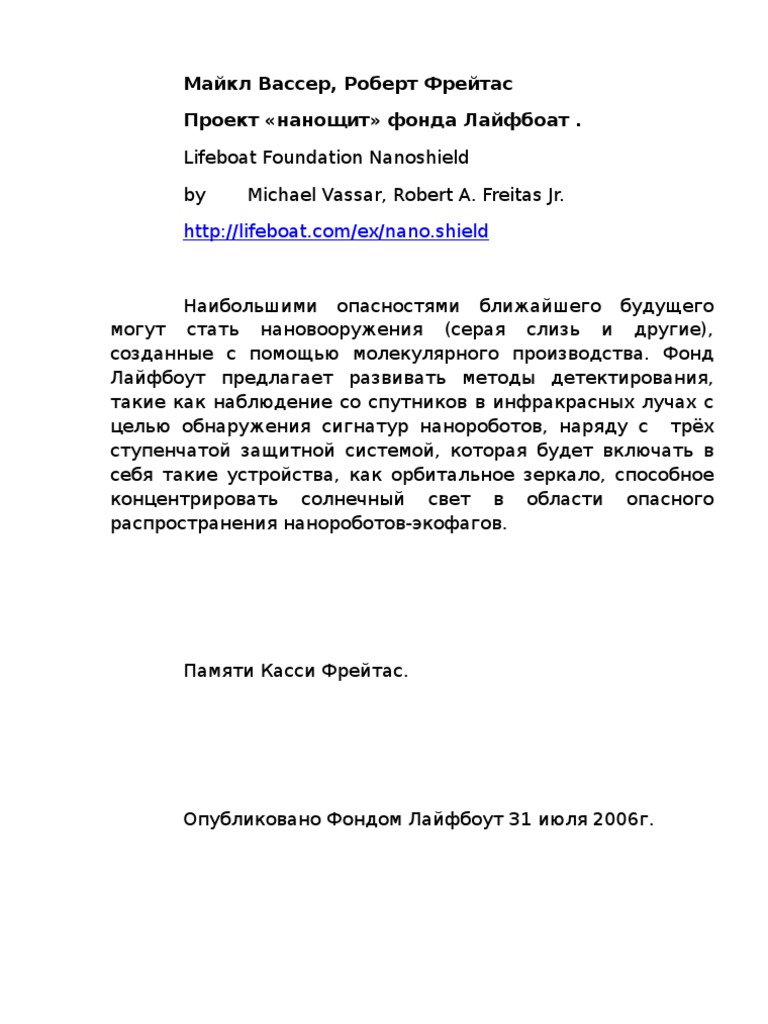 I have translated into Russian “Lifeboat Foundation Nanoshield” http://www.scribd.com/doc/12113758/Nano-Shield and I have some thoughts about it:
I have translated into Russian “Lifeboat Foundation Nanoshield” http://www.scribd.com/doc/12113758/Nano-Shield and I have some thoughts about it:
1) The effective mean of defense against ecofagy would be to turn in advance all the matter on the Earth into nanorobots. Just as every human body is composed of living cells (although this does not preclude the emergence of cancer cells). The visible world would not change. All object will consist of nano-cells, which would have sufficient immune potential to resist almost any foreseeable ecofagy. (Except purely informational like computer viruses). Even in each leaving cell would be small nanobot, which would control it. Maybe the world already consists of nanobots.
2) The authors of the project suggest that ecofagic attack would consist of two phases — reproduction and destruction. However, creators of ecofagy, could make three phases — first phase would be a quiet distribution throughout the Earth’s surface, under surfase, in the water and air. In this phase nanorobots will multiply in slow rate, and most importantly, sought to be removed from each other on the maximum distance. In this case, their concentration everywhere on the Earth as a result would be 1 unit on the cube meter (which makes them unrecognazible). And only after it they would start to proliferate intensely, simultaneously creating nanorobots soldiers who did not replicate, but attack the defensive system. In doing so, they first have to suppress protection systems, like AIDS. Or as a modern computer viruses switches off the antivirus. Creators of the future ecofagy must understand it. As the second phase of rapid growth begins everywhere on the surface of the Earth, then it would be impossible to apply the tools of destruction such as nuclear strikes or aimed rays, as this would mean the death of the planet in any case — and simply would not be in store enough bombs.
3) The authors overestimate the reliability of protection systems. Any system has a control center, which is a blank spot. The authors implicitly assume that any person with a certain probability can suddenly become terrorist willing to destroy the world (and although the probability is very small, a large number of people living on Earth make it meaningful). But because such a system will be managed by people, they may also want to destroy the world. Nanoshield could destroy the entire world after one erroneous command. (Even if the AI manages it, we cannot say a priori that the AI cannot go mad.) The authors believe that multiple overlapping of Nanoshield protection from hackers will make it 100 % safe, but no known computer system is 100 % safe – but all major computer programs were broken by hackers, including Windows and IPod.
4) Nanoshield could develop something like autoimmunity reaction. The author’s idea that it is possible to achieve 100 % reliability by increasing the number of control systems is very superficial, as well as the more complex is the system, the more difficult is to calculate all the variants of its behavior, and the more likely it will fail in the spirit of the chaos theory.
5) Each cubic meter of oceanic water contains 77 million living beings (on the northern Atlantic, as the book «Zoology of Invertebrates» tells). Hostile ecofages can easily camouflage under natural living beings, and vice versa; the ability of natural living beings to reproduce, move and emit heat will significantly hamper detection of ecofages, creating high level of false alarms. Moreover, ecofages may at some stage in their development be fully biological creatures, where all blueprints of nanorobot will be recorded in DNA, and thus be almost no distinguishable from the normal cell.
6) There are significant differences between ecofages and computer viruses. The latter exist in the artificial environment that is relatively easy to control — for example, turn off the power, get random access to memory, boot from other media, antivirus could be instantaneous delivered to any computer. Nevertheless, a significant portion of computers were infected with a virus, but many users are resigned to the presence of a number of malware on their machines, if it does not slow down much their work.
7) Compare: Stanislaw Lem wrote a story “Darkness and mold” with main plot about ecofages.
8 ) The problem of Nanoshield must be analyzed dynamically in time — namely, the technical perfection of Nanoshield should precede technical perfection of nanoreplikators in any given moment. From this perspective, the whole concept seems very vulnerable, because to create an effective global Nanoshield require many years of development of nanotechnology — the development of constructive, and political development — while creating primitive ecofages capable, however, completely destroy the biosphere, is required much less effort. Example: Creating global missile defense system (ABM – still not exist) is much more complex technologically and politically, than the creation of intercontinental nuclear missiles.
9) You should be aware that in the future will not be the principal difference between computer viruses and biological viruses and nanorobots — all them are information, in case of availability of any «fabs» which can transfer information from one carrier to another. Living cells could construct nanorobots, and vice versa; spreading over computer networks, computer viruses can capture bioprinters or nanofabs and force them to perform dangerous bioorganizms or nanorobots (or even malware could be integrated into existing computer programs, nanorobots or DNA of artificial organisms). These nanorobots can then connect to computer networks (including the network which control Nanoshield) and send their code in electronic form. In addition to these three forms of the virus: nanotechnology, biotechnology and computer, are possible other forms, for example, cogno — that is transforming the virus in some set of ideas in the human brain which push the man to re-write computer viruses and nanobots. Idea of “hacking” is now such a meme.
10) It must be noted that in the future artificial intelligence will be much more accessible, and thus the viruses would be much more intelligent than today’s computer viruses, also applies to nanorobots: they will have a certain understanding of reality, and the ability to quickly rebuild itself, even to invent its innovative design and adapt to new environments. Essential question of ecofagy is whether individual nanorobots are independent of each other, as the bacteria cells, or they will act as a unified army with a single command and communication systems. In the latter case, it is possible to intercept the management of hostile army ecofages.
11) All that is suitable to combat ecofagy, is suitable as a defensive (and possibly offensive) weapons in nanowar.
12) Nanoshield is possible only as global organization. If there is part of the Earth which is not covered by it, Nanoshield will be useless (because there nanorobots will multiply in such quantities that it would be impossible to confront them). It is an effective weapon against people and organizations. So, it should occur only after full and final political unification of the globe. The latter may result from either World War for the unification of the planet, either by merging of humanity in the face of terrible catastrophes, such as flash of ecofagy. In any case, the appearance of Nanoshield must be preceded by some accident, which means a great chance of loss of humanity.
13) Discovery of «cold fusion» or other non-conventional energy sources will make possible much more rapid spread of ecofagy, as they will be able to live in the bowels of the earth and would not require solar energy.
14) It is wrong to consider separately self-replicating and non-replitcating nanoweapons. Some kinds of ecofagy can produce nano-soldiers attacking and killing all life. (This ecofagy can become a global tool of blackmail.) It has been said that to destroy all people on the Earth can be enough a few kilograms of nano-soldiers. Some kinds of ecofagy in early phase could dispersed throughout the world, very slowly and quietly multiply and move, and then produce a number of nano-soldiers and attack humans and defensive systems, and then begin to multiply intensively in all areas of the globe. But man, stuffed with nano-medicine, can resist attack of nanosoldier as well as medical nanorobots will be able to neutralize any poisons and tears arteries. In this small nanorobot must attack primarily informational, rather than from a large selection of energy.
15) Did the information transparency mean that everyone can access code of dangerous computer virus, or description of nanorobot-ecofage? A world where viruses and knowledge of mass destruction could be instantly disseminated through the tools of information transparency is hardly possible to be secure. We need to control not only nanorobots, but primarily persons or other entities which may run ecofagy. The smaller is the number of these people (for example, scientists-nanotechnologist), the easier would be to control them. On the contrary, the diffusion of knowledge among billions of people will make inevitable emergence of nano-hackers.
16) The allegation that the number of creators of defense against ecofagy will exceed the number of creators of ecofagy in many orders of magnitude, seems doubtful, if we consider an example of computer viruses. Here we see that, conversely, the number of virus writers in the many orders of magnitude exceeds the number of firms and projects on anti-virus protection, and moreover, the majority of anti-virus systems cannot work together as they stops each other. Terrorists may be masked by people opposing ecofagy and try to deploy their own system for combat ecofagy, which will contain a tab that allows it to suddenly be reprogrammed for the hostile goal.
17) The text implicitly suggests that Nanoshield precedes to the invention of self improving AI of superhuman level. However, from other prognosis we know that this event is very likely, and most likely to occur simultaneously with the flourishing of advanced nanotechnology. Thus, it is not clear in what timeframe the project Nanoshield exist. The developed artificial intelligence will be able to create a better Nanoshield and Infoshield, and means to overcome any human shields.
18) We should be aware of equivalence of nanorobots and nanofabrics — first can create second, and vice versa. This erases the border between the replicating and non-replicating nanomachines, because a device not initially intended to replicate itself can construct somehow nanorobot or to reprogram itself into capable for replication nanorobot.

 I have translated into Russian “Lifeboat Foundation Nanoshield”
I have translated into Russian “Lifeboat Foundation Nanoshield” 







